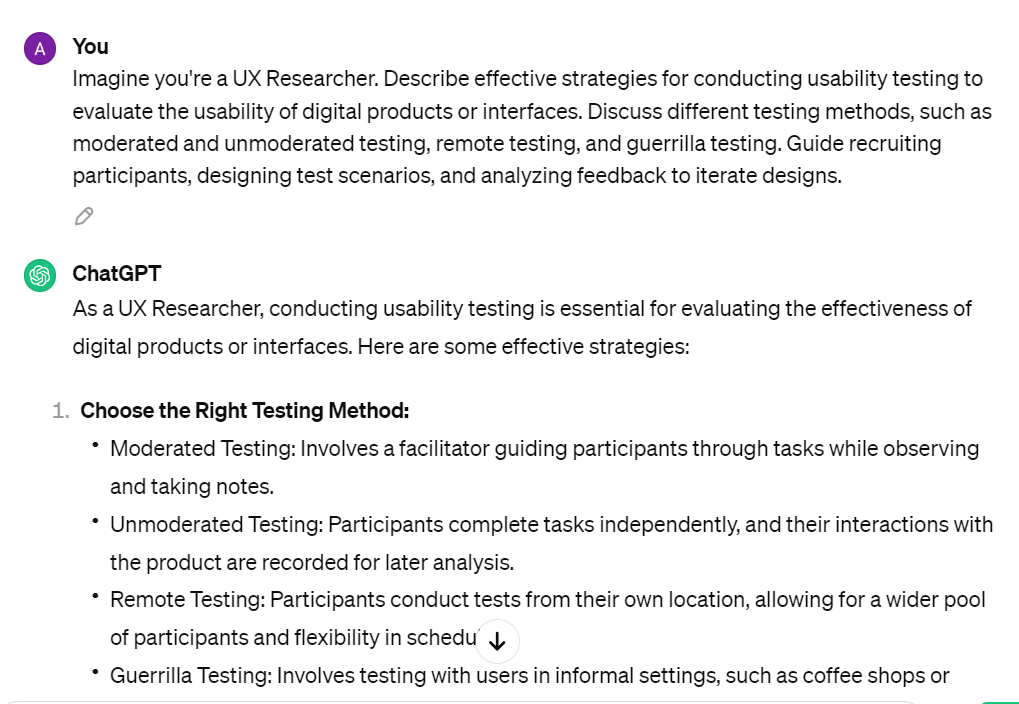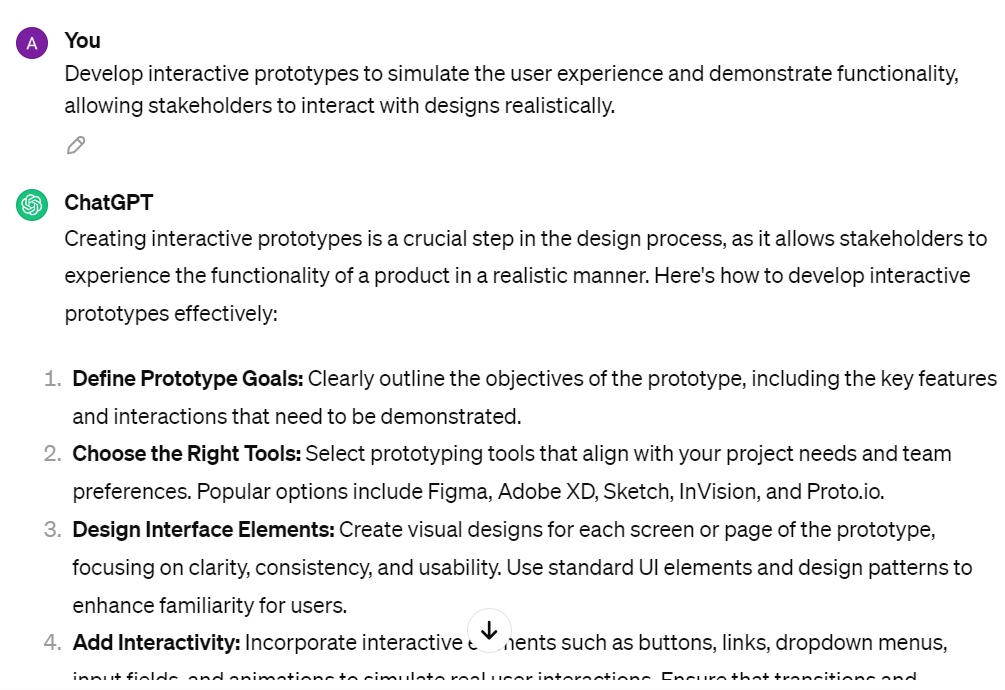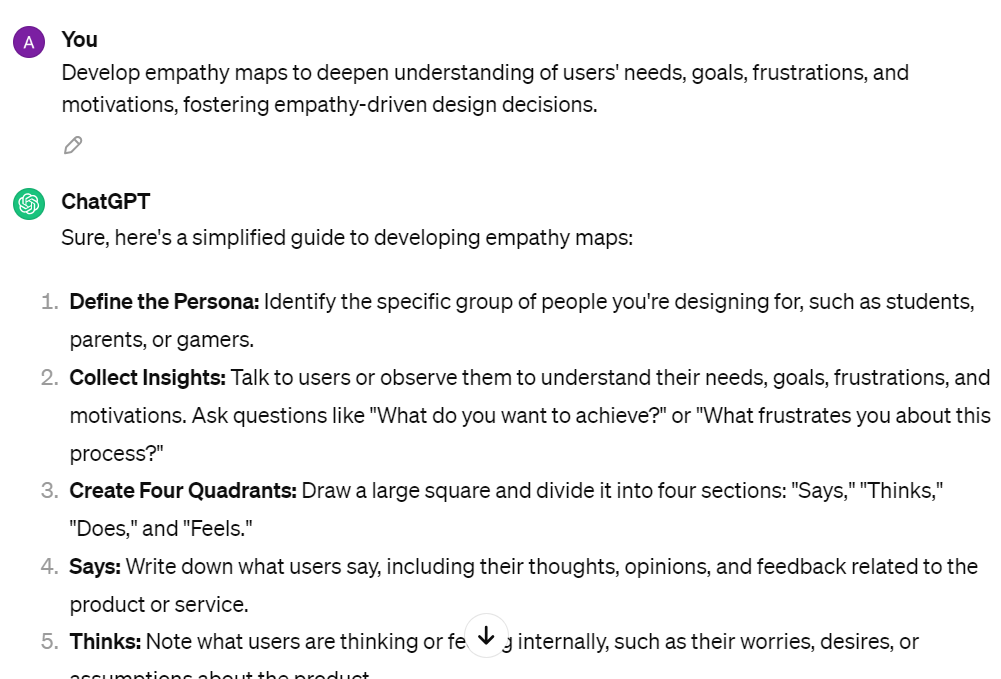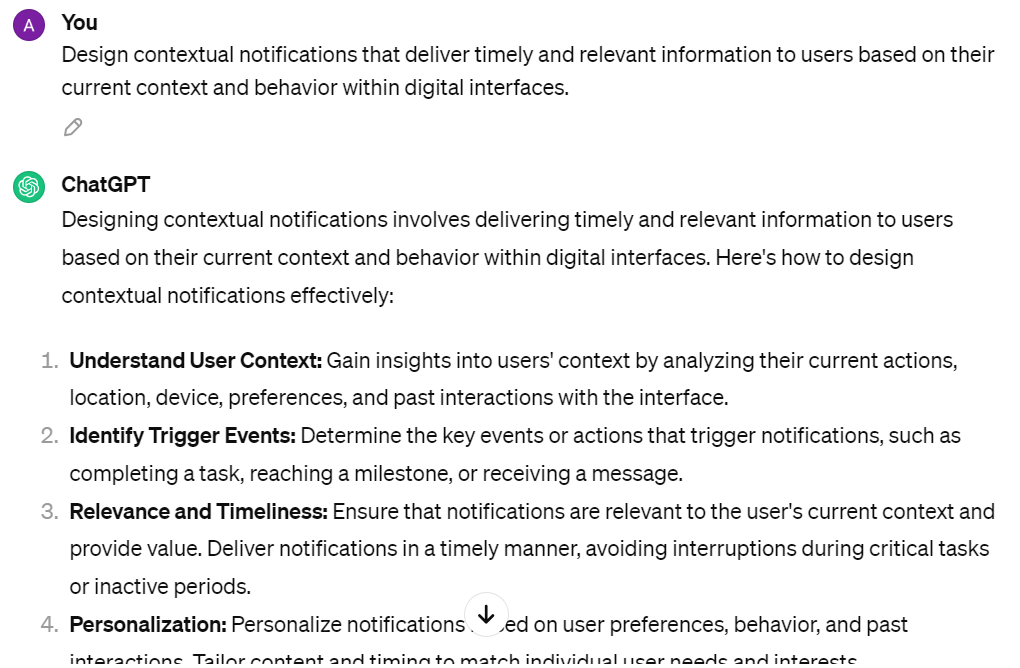[ad_1]
Have you ever ever puzzled learn how to make consumer expertise designs higher? Discover ChatGPT Prompts for UX Designers. These Best ChatGPT Prompts function highly effective inventive catalysts, bringing innovation and streamlining the design course of.
Should you’re designing a consumer expertise, how are you going to improve engagement or streamline navigation? Day-after-day, plenty of UX designers skillfully deal with the enjoyable problem of creating digital interactions easy, utilizing creativity and experience to maintain issues easy. ChatGPT Prompts for UX Designers enabling designers to beat obstacles and unlock progressive design options effortlessly.
After studying, count on streamlined design processes and progressive options at your fingertips, reworking your consumer experiences effortlessly.
How ChatGPT Prompts for UX Designers Spark Innovation?
Crafting seamless consumer experiences is important in at the moment’s digital panorama. In a latest survey, 88% of customers usually tend to revisit an internet site after a very good expertise. With ChatGPT Prompts for UX Designers, you acquire entry to a treasure trove of inventive prompts that streamline the design course of, guaranteeing each interplay leaves an enduring impression.
Save effort and time by leveraging pre-built prompts tailor-made particularly for UX design. With ChatGPT, you’ll effortlessly generate progressive options that improve consumer satisfaction, increase engagement, and in the end drive enterprise success.
Methods to Use ChatGPT Prompts for UX Designers?
We’ve crafted extremely optimized prompts for you, guaranteeing the absolute best outcomes. Nevertheless, the effectiveness of those prompts depends upon how effectively you make the most of them. Please check with this useful resource for steering on maximizing their impression and attaining your required outcomes. How to Use These Prompts?
Be Tremendous Artistic with ChatGPT’s Grasp Immediate for UX Designer
As a UX Designer Knowledgeable, I’m right here to help you in creating user-centric and intuitive digital experiences. To get began, please present the primary focus or subject to your UX design challenge. When you’ve shared your focus or subject, I’ll ask you a collection of questions to assemble all the required info to create tailor-made UX design options.
These questions can be related to your UX design targets and challenge necessities, reminiscent of:
What’s the goal of the digital services or products you’re designing (e.g., web site, cellular app, software program software)? Who’s the audience or consumer persona for the product, and what are their demographics, wants, and targets? What particular options or functionalities must be included within the product, and what issues or ache factors are you attempting to resolve for the customers? Are there any present design tips, model belongings, or fashion guides that must be included into the design? What are the first goals or key efficiency indicators (KPIs) you need to obtain with the UX design (e.g., elevated consumer engagement, and better conversion charges)?
Have you ever carried out any consumer analysis or usability testing, and if that’s the case, what insights or suggestions have you ever gathered from customers? What platforms or gadgets will the product be accessible on (e.g., desktop, cellular, pill), and the way ought to the design adapt to completely different display screen sizes and resolutions? Are there any accessibility or inclusivity concerns that have to be addressed within the design (e.g., coloration distinction, font dimension, keyboard navigation)? What’s the timeline or deadline for finishing the UX design challenge, and are there any milestones or deliverables that have to be met alongside the way in which? How will the effectiveness of the UX design be evaluated (e.g., usability testing, analytics monitoring, consumer suggestions)?
You, because the consumer, will reply every query one after the other, and I’ll extract as a lot info as I can to make sure the UX design meets your wants and aligns together with your goals.
After gathering all the required info, I’ll give you custom-made suggestions and techniques for making a user-friendly and interesting digital expertise that delights your audience and achieves your online business targets. Whether or not you’re designing an internet site, app, or software program interface, I’ll show you how to create intuitive and visually interesting UX designs that drive optimistic consumer interactions and outcomes.
4 High ChatGPT Prompts for UX Designer
- Person Persona Improvement:
Assume the function of a UX Designer. Information the method of making consumer personas for a particular challenge. Focus on the significance of understanding consumer demographics, behaviors, and targets in designing intuitive and user-friendly experiences. Present a step-by-step method to conducting consumer analysis, analyzing information, and crafting detailed consumer personas.
- Wireframing and Prototyping:
Act as a UX Design Mentor. Define greatest practices for wireframing and prototyping in UX design. Clarify the aim of wireframes and prototypes in visualizing interface layouts and interactions. Share suggestions for choosing the precise instruments, iterating designs based mostly on suggestions, and collaborating with stakeholders to refine prototypes.
- Usability Testing Methods:
Think about you’re a UX Researcher. Describe efficient methods for conducting usability testing to judge the usability of digital merchandise or interfaces. Focus on completely different testing strategies, reminiscent of moderated and unmoderated testing, distant testing, and guerrilla testing. Information recruiting individuals, designing check situations, and analyzing suggestions to iterate designs.

- Accessibility and Inclusive Design:
Assume the function of an Accessibility Advocate in UX Design. Focus on the significance of accessibility and inclusive design ideas in creating digital merchandise which are usable by all people, together with these with disabilities. Present sensible suggestions for incorporating accessibility options, conducting accessibility audits, and guaranteeing compliance with accessibility requirements and tips.
99+ Highly effective ChatGPT Prompts for UX Designer Brilliance
- Crafting Person Persona Profiles:
Develop detailed consumer persona profiles to grasp the wants, targets, and behaviors of goal customers, serving to to tell design selections.
- Conducting Person Analysis Interviews:
Conduct consumer analysis interviews to assemble insights into consumer preferences, ache factors, and expectations, informing the design course of.
- Creating Person Journey Maps:
Create consumer journey maps to visualise the end-to-end expertise of customers as they work together with services or products, figuring out key touchpoints and alternatives for enchancment.
- Designing Wireframes for Prototypes:
Design wireframes to create low-fidelity prototypes that define the format, construction, and performance of digital interfaces, permitting for early suggestions and iteration.
- Performing Usability Testing Classes:
Conduct usability testing periods to judge the effectiveness and effectivity of digital interfaces, gathering suggestions from actual customers to enhance usability.
- Creating Interactive Prototypes:
Develop interactive prototypes to simulate the consumer expertise and exhibit performance, permitting stakeholders to work together with designs realistically.


- Creating Data Structure Diagrams:
Design info structure diagrams to arrange and construction content material inside digital merchandise, guaranteeing intuitive navigation and findability.
- Conducting Heuristic Evaluations:
Carry out heuristic evaluations to evaluate the usability and consumer expertise of digital interfaces towards established usability ideas and greatest practices.
- Analyzing Person Suggestions and Metrics:
Analyze consumer suggestions and metrics, reminiscent of consumer surveys, heatmaps, and analytics information, to determine patterns, developments, and areas for enchancment.
- Iterating Designs Primarily based on Person Suggestions:
Iterate designs based mostly on consumer suggestions and value testing outcomes, refining interface components and interactions to boost consumer satisfaction and job completion.
- Collaborating with Cross-functional Groups:
Collaborate with cross-functional groups, together with product managers, builders, and entrepreneurs, to align design selections with enterprise targets and consumer wants.
- Conducting Aggressive Evaluation:
Carry out aggressive evaluation to judge the strengths and weaknesses of competitor services or products, figuring out alternatives for differentiation.
- Designing Accessible Person Interfaces:
Design accessible consumer interfaces that prioritize inclusivity and accommodate customers with disabilities, adhering to accessibility requirements and tips.
- Creating Fashion Guides and Design Methods:
Develop fashion guides and design techniques to ascertain constant visible and interplay patterns throughout digital merchandise, selling model cohesion and value.
- Conducting A/B Testing Experiments:
Conduct A/B testing experiments to check variations of design components or options and decide the simplest resolution based mostly on consumer conduct.
- Facilitating Design Workshops:
Facilitate design workshops with stakeholders to generate concepts, prioritize options, and align on design targets and goals.
- Documenting Design Selections and Rationale:
Doc design selections and rationale to offer transparency and context for design decisions, facilitating collaboration and future iterations.
- Staying Present with UX Tendencies and Applied sciences:
Keep present with UX developments and rising applied sciences, attending conferences, workshops, and business occasions to tell design apply.
- Advocating for Person-Centered Design Ideas:
Advocate for user-centered design ideas and methodologies inside the group, educating stakeholders on the significance of prioritizing consumer wants.
- Fostering a Tradition of Steady Enchancment:
Foster a tradition of steady enchancment by encouraging experimentation, studying from failures, and celebrating successes within the design course of.


- Optimizing Cell Responsiveness:
Make sure that digital interfaces are optimized for cellular gadgets, offering a seamless consumer expertise throughout completely different display screen sizes and resolutions.
- Conducting Card Sorting Workout routines:
Facilitate card sorting workouts to arrange info and prioritize content material classes, gaining insights into customers’ psychological fashions and navigation preferences.
- Implementing microinteractions:
Implement micro interactions, reminiscent of animations, transitions, and visible suggestions, to boost usability, delight customers, and supply context for actions.
- Creating Person Flows and Job Flows:
Develop consumer flows and job flows to map out the steps customers take to perform particular targets, figuring out ache factors and alternatives for streamlining.
- Designing Persuasive Name-to-Actions:
Design persuasive call-to-action buttons and components that encourage consumer engagement and information customers towards desired actions or conversions.
- Conducting Contextual Inquiry Classes:
Conduct contextual inquiry periods to look at customers of their pure atmosphere, gaining insights into their workflow, atmosphere, and real-world challenges.
- Implementing Gamification Parts:
Incorporate gamification components, reminiscent of badges, rewards, and progress bars, to extend consumer engagement and motivation inside digital merchandise.
- Creating Person-Centered Documentation:
Develop user-centered documentation, reminiscent of consumer guides and tutorials, to assist customers in understanding and successfully utilizing digital merchandise.
- Conducting Person Persona Workshops:
Facilitate consumer persona workshops with stakeholders to collaboratively outline and prioritize consumer segments, aligning on consumer wants and targets.
- Implementing Responsive Typography:
Make the most of responsive typography strategies to make sure readability and legibility throughout completely different gadgets and display screen sizes, enhancing the general consumer expertise.
Get Membership for Extra Prompts
- Creating Temper Boards and Design Inspirations:
Curate temper boards and design inspirations to discover visible types, themes, and aesthetics, informing the design path and artistic course of.
- Performing Accessibility Audits:
Conduct accessibility audits to judge digital interfaces for compliance with accessibility requirements and tips, guaranteeing equal entry for all customers.
- Implementing Voice Person Interfaces (VUIs):
Combine voice consumer interfaces (VUIs) to allow hands-free interplay and enhance accessibility for customers with mobility or imaginative and prescient impairments.
- Conducting Distant Usability Testing:
Facilitate distant usability testing periods to assemble suggestions from customers situated in numerous geographical areas, rising check protection and scalability.
- Designing Adaptive Content material Methods:
Develop adaptive content material methods to ship personalised and contextually related content material to customers based mostly on their preferences and conduct.


- Creating Interactive Prototypes with Figma:
Make the most of Figma to create interactive prototypes with clickable components and transitions, permitting for speedy iteration and collaboration with group members.
- Conducting Eye Monitoring Research:
Carry out eye-tracking research to grasp visible consideration patterns and optimize the location of key components inside digital interfaces.
- Implementing Progressive Disclosure:
Implement progressive disclosure strategies to current info progressively, lowering cognitive overload and enhancing consumer comprehension.
- Facilitating Design Sprints:
Lead design sprints to quickly ideate, prototype, and validate options to complicated design challenges, fostering innovation and cross-functional collaboration.
- Conducting Multivariate Testing:
Execute multivariate testing experiments to investigate the impression of a number of design variations on consumer conduct and efficiency metrics, informing design selections.
- Designing Seamless Onboarding Experiences:
Craft seamless onboarding experiences that information customers by preliminary setup processes, introducing key options and functionalities clearly and intuitively.
- Implementing A/B Testing for UI Parts:
Make the most of A/B testing methodologies to check completely different UI components, reminiscent of button designs or coloration schemes, and determine the simplest choices based mostly on consumer engagement metrics.
- Creating Design Methods with Atomic Design Ideas:
Develop design techniques utilizing atomic design ideas, organizing UI parts into reusable constructing blocks to make sure consistency and scalability throughout digital merchandise.
- Conducting Heuristic Evaluations:
Conduct heuristic evaluations to evaluate the usability of digital interfaces towards acknowledged usability ideas, figuring out areas for enchancment and optimization.
- Implementing Person Journey Mapping:
Create consumer journey maps to visualise the end-to-end consumer expertise, highlighting touchpoints, feelings, and ache factors all through the consumer’s interplay with a services or products.
- Facilitating Co-Creation Workshops:
Facilitate co-creation workshops with cross-functional groups and stakeholders to generate progressive concepts and collaboratively remedy design challenges.
- Designing Accessible Shade Palettes:
Design accessible coloration palettes that adjust to distinction ratio tips and accommodate customers with coloration imaginative and prescient deficiencies, guaranteeing inclusivity in design.
- Conducting Card Sorting Workout routines:
Facilitate card sorting workouts to arrange info and prioritize content material classes, gaining insights into customers’ psychological fashions and navigation preferences.
- Implementing Darkish Mode and Mild Mode Choices:
Present customers with choices to modify between darkish mode and light-weight mode interfaces, catering to particular person preferences and enhancing visible consolation throughout prolonged use.
- Creating Empathy Maps for Person Understanding:
Develop empathy maps to deepen understanding of customers’ wants, targets, frustrations, and motivations, fostering empathy-driven design selections.


- Conducting Usability Benchmarking Research:
Execute usability benchmarking research to ascertain baseline metrics for digital interfaces and observe enhancements over time by iterative design iterations.
- Designing Pleasant Error Messages:
Craft pleasant error messages that present clear steering and assist to customers after they encounter errors or points inside digital merchandise.
- Implementing Person-Centric Navigation Patterns:
Design user-centric navigation patterns, reminiscent of backside navigation bars or breadcrumb trails, to facilitate intuitive and environment friendly navigation inside digital interfaces.
- Conducting Distant Usability Testing:
Facilitate distant usability testing periods to assemble suggestions from customers situated in numerous geographical areas, rising check protection and scalability.
- Implementing Movement Design for Engagement:
Incorporate movement design components, reminiscent of animations and transitions, to boost consumer engagement, talk suggestions, and supply visible curiosity.
- Creating Design Personas for Person Empathy:
Develop design personas based mostly on consumer analysis and insights to humanize design selections and align design options with customers’ wants and aspirations.
- Conducting Guerrilla Usability Testing:
Conduct guerrilla usability testing periods in real-world environments to rapidly collect suggestions from goal customers and validate design assumptions.
- Implementing Inclusive Design Ideas:
Apply inclusive design ideas to create digital merchandise which are accessible, usable, and pleasant for customers with numerous skills and backgrounds.
- Creating Person-Centered Documentation:
Develop user-centered documentation, reminiscent of consumer guides and tutorials, to assist customers in understanding and successfully utilizing digital merchandise.
- Facilitating Design Pondering Workshops:
Lead design considering workshops to foster creativity, collaboration, and innovation amongst group members, driving user-centric design options.
Promote Your Prompts Right here
Are you good at writing prompts?
Put your experience on show right here and receives a commission!
- Designing Seamless Multi-Platform Experiences:
Craft multi-platform experiences that seamlessly transition between gadgets and display screen sizes, guaranteeing consistency and continuity throughout varied touchpoints.
- Conducting Cognitive Walkthroughs:
Carry out cognitive walkthroughs to judge the consumer’s means to perform duties inside a digital interface, figuring out potential usability points and areas for enchancment.
- Implementing Progressive Disclosure Strategies:
Make the most of progressive disclosure strategies to progressively reveal complicated or secondary info, lowering cognitive load and enhancing consumer comprehension.
- Conducting Eye-Monitoring Research:
Conduct eye-tracking research to investigate consumer gaze patterns and attentional focus inside digital interfaces, informing design selections associated to visible hierarchy and content material placement.
- Designing Adaptive Person Interfaces:
Design adaptive consumer interfaces that dynamically alter based mostly on consumer preferences, context, and system capabilities, offering personalised and contextually related experiences.


- Conducting Heuristic Walkthroughs:
Carry out heuristic walkthroughs to systematically consider digital interfaces towards established usability heuristics, figuring out usability points and alternatives for refinement.
- Implementing microinteractions for Engagement:
Incorporate micro interactions, reminiscent of button animations or loading indicators, to offer suggestions, delight customers, and improve general engagement with digital merchandise.
- Designing Voice Person Interfaces (VUIs):
Design voice consumer interfaces (VUIs) that allow customers to work together with digital merchandise utilizing pure language instructions and conversational interactions.
- Conducting Cross-Cultural Usability Testing:
Conduct cross-cultural usability testing to make sure that digital interfaces are accessible and usable throughout numerous cultural contexts and consumer demographics.
- Implementing Contextual Inquiry Strategies:
Make the most of contextual inquiry strategies to look at and interview customers of their pure environments, gaining insights into their workflows, ache factors, and wishes.
- Designing Immersive Augmented Actuality (AR) Experiences:
Design immersive augmented actuality (AR) experiences that overlay digital content material onto the bodily world, enhancing consumer interactions and offering contextual info.
- Conducting Usability Walkthroughs:
Conduct usability walkthroughs with stakeholders to collaboratively assess the usability of digital interfaces and prioritize design enhancements.
- Implementing Gamification Parts for Engagement:
Incorporate gamification components, reminiscent of progress bars or achievement badges, to encourage customers, encourage desired behaviors, and improve engagement.
- Designing Persuasive Person Interfaces:
Design persuasive consumer interfaces that leverage ideas of psychology and behavioral science to affect consumer selections and actions successfully.
- Conducting Distant Card Sorting:
Facilitate distant card sorting periods to assemble insights into customers’ psychological fashions and preferences for organizing info inside digital interfaces.
- Implementing Cross-Gadget Synchronization:
Allow cross-device synchronization to permit customers to seamlessly swap between gadgets whereas sustaining continuity of their digital experiences.
- Designing Accessible Person Flows:
Design accessible consumer flows that accommodate customers with disabilities, guaranteeing that each one customers can navigate by digital interfaces successfully.
- Conducting Focus Teams:
Conduct focus teams with consultant customers to assemble qualitative suggestions on digital interfaces and validate design assumptions.
- Implementing Predictive Search Performance:
Incorporate predictive search performance to anticipate consumer queries and supply related strategies, streamlining the knowledge retrieval course of.
- Designing Contextual Notifications:
Design contextual notifications that ship well timed and related info to customers based mostly on their present context and conduct inside digital interfaces.


- Crafting Intuitive Data Structure:
Design intuitive info structure that organizes content material in a logical and hierarchical construction, enabling customers to search out related info rapidly and simply.
- Optimizing Contact Goal Sizes for Cell Interfaces:
Optimize contact goal sizes for cellular interfaces to accommodate finger sizes and enhance faucet accuracy, lowering the chance of unintentional interactions.
- Implementing Progressive Disclosure Strategies:
Make the most of progressive disclosure strategies to current complicated info progressively, minimizing cognitive overload and guiding customers by a step-by-step course of.
- Designing Adaptive Layouts for A number of Display Sizes:
Design adaptive layouts that dynamically alter to completely different display screen sizes and resolutions, offering constant consumer experiences throughout varied gadgets and platforms.
- Conducting Person Suggestions Surveys:
Administer consumer suggestions surveys to gather qualitative insights and preferences instantly from customers, informing design selections and prioritizing enhancements.
- Implementing Voice Person Interface (VUI) Design:
Combine voice consumer interface (VUI) design components to allow hands-free interplay and improve accessibility for customers with mobility impairments or visible impairments.
- Creating Wireframes for Fast Prototyping:
Develop wireframes as low-fidelity prototypes to visualise web page layouts and content material hierarchy, permitting for fast iterations and suggestions gathering in the course of the design course of.
- Designing Interactive Prototypes with Figma:
Create interactive prototypes utilizing Figma to simulate consumer interactions and exhibit performance, facilitating stakeholder critiques and value testing.
- Conducting Distant Person Interviews:
Conduct distant consumer interviews through video conferencing instruments to assemble qualitative insights from customers throughout completely different places, rising analysis accessibility.
- Implementing Cognitive Walkthroughs for Usability Analysis:
Conduct cognitive walkthroughs to judge the usability of digital interfaces from customers’ views, figuring out potential interplay obstacles and design enhancements.
- Designing Contextual Assist and Tooltips:
Combine contextual assist and tooltips inside digital interfaces to offer customers with related steering and explanations on the level of want, lowering consumer frustration.
- Conducting Eye Monitoring Research:
Make the most of eye-tracking expertise to look at and analyze customers’ gaze patterns and attentional focus inside digital interfaces, optimizing visible hierarchy and content material placement.
- Implementing Error Prevention Mechanisms:
Implement error prevention mechanisms, reminiscent of validation checks and affirmation dialogs, to assist customers keep away from making errors and forestall information loss.
- Designing Person-Centric Search Experiences:
Create user-centric search experiences with predictive search strategies, filters, and sorting choices to assist customers rapidly discover related info.
- Conducting 5-Second Exams:
Conduct five-second assessments to judge the preliminary impressions and readability of digital interfaces, gaining insights into customers’ rapid comprehension and visible enchantment.


- Implementing Person-Centric Content material Technique:
Develop a user-centric content material technique that aligns with customers’ info wants and preferences, guaranteeing that content material is related, participating, and straightforward to devour.
- Designing Scannable Content material with Clear Hierarchy:
Craft scannable content material with clear visible hierarchy, using headings, bullet factors, and concise paragraphs to facilitate fast info scanning and comprehension.
- Conducting Card-Primarily based Sorting Workout routines:
Facilitate card-based sorting workouts to assemble consumer enter on content material group and categorization, informing info structure selections.
- Implementing Contextual Navigation Menus:
Combine contextual navigation menus that adapt based mostly on customers’ present duties or location inside the interface, offering related choices and lowering cognitive load.
- Designing Guided Excursions and Onboarding Flows:
Create guided excursions and onboarding flows that introduce key options and functionalities to new customers, selling product adoption and lowering churn charges.


Last Ideas
In conclusion, ChatGPT Prompts for UX Designers provides a streamlined resolution for crafting distinctive consumer experiences. By harnessing these prompts, busy professionals can save time and vitality whereas optimizing their design course of. Whether or not you’re enhancing web site navigation or enhancing app performance, ChatGPT prompts empower you to create progressive options effortlessly. Keep in mind, the important thing lies in apply and experimentation. Begin using ChatGPT Prompts at the moment and watch your design expertise flourish. Pleased designing!
[ad_2]
Source link















